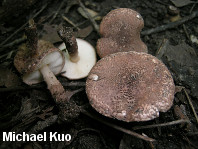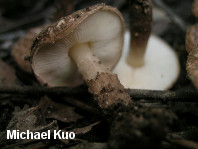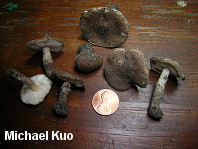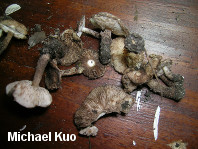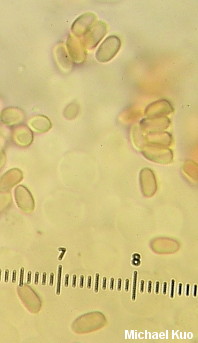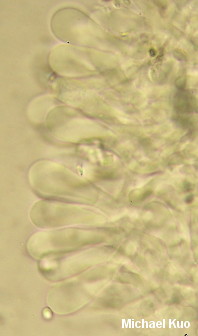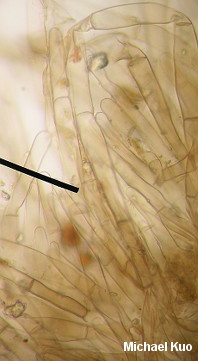| Major Groups > Gilled Mushrooms > Pale-Spored > Lepiotoid Mushrooms > Lepiota eriophora |

|
Lepiota eriophora [ Basidiomycota > Agaricales > Agaricaceae > Lepiota . . . ] by Michael Kuo My use of the name Lepiota eriophora for the mushroom described and illustrated here is tentative. Peck's original 1903 description of Lepiota eriophora recounts a small, thin-capped, brown lepiotoid mushroom with very small spores and a stem "clothed with brown tomentum." The cap is brown, and features scales that are "compact" and "sometimes pointed." The gills are described as darkening with age, and on drying. A few years after Peck's original publication, Morgan (1906, p. 201) treated Lepiota eriophora as a synonym of Then the Europeans took Peck's North American name out for a spin; Reid (1958) applied the name to collections made in Great Britain, and various European authors expanded use of the name. However, Reid had in mind a species with a prominently scaly stem, rather than one clothed with tomentum, and Vellinga (2001h) later synonymized Reid's concept of Lepiota eriophora with Lepiota pseudoasperula. If your eyes are starting to glaze over, I don't blame you. Just allow me to finish by saying that, if I am applying Peck's original concept correctly, Lepiota eriophora is actually fairly distinct among the small-spored, brown, scaly-capped species; its stem is sheathed with brown tomentum, its gills darken with age, and, under the microscope, it lacks both clamp connections and the chains of inflated, subglobose cells that characterize the scales of Lepiota asperula and other members of the Lepiota aspera group. Description: Ecology: Saprobic; growing scattered or gregariously in hardwood forests; fall; originally described from West Virginia; distribution uncertain. The illustrated and described collection is from Illinois. Cap: 1.5-4 cm across; thin; convex at first, becoming flat in age; dry; very finely scaly; dark gray-brown when young; in older specimens faintly tan under the scales. Gills: Free from the stem; close or crowded; short-gills frequent; white; developing brown edges and spots with age and eventually discoloring brownish to brown overall. Stem: 2-4 cm long; 4-6 mm thick; slightly swollen in the middle; dry; whitish and bald above; sheathed with brown tomentum below; with a poorly defined ring zone. Flesh: White; not changing when sliced. Odor: Fragrant. Chemical Reactions: KOH negative on cap surface and on flesh. Spore Print: White. Microscopic Features: Spores 3-4 x 1.5-2 µ; long-ellipsoid; smooth; hyaline in KOH; dextrinoid; tending to cohere in groups when free floating. Cheilocystidia 25-30 x 7.5-10 µ; clavate to subclavate or widely cylindric; septate; hyaline in KOH; thin-walled. Pleurocystidia not found. Pileipellis a trichoderm of cylindric hyphae REFERENCES: Peck, 1903. (Peck, 1906; Kauffman, 1918; Kauffman, 1924.) Herb. Kuo 09291103. This site contains no information about the edibility or toxicity of mushrooms. |
© MushroomExpert.Com |
|
Cite this page as: Kuo, M. (2015, September). Lepiota eriophora. Retrieved from the MushroomExpert.Com Web site: http://www.mushroomexpert.com/lepiota_eriophora.html |
